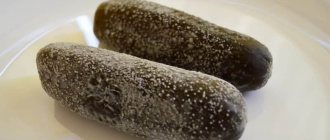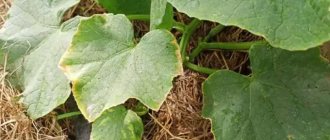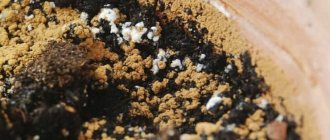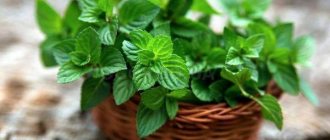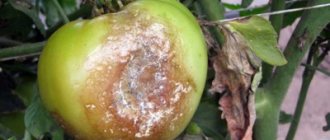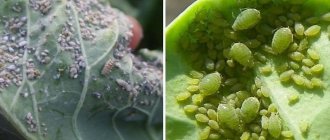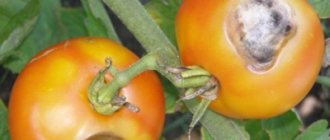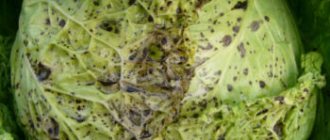White plaque on cucumbers - what is it?
This coating has different origins depending on the preparation technology and the composition of the workpiece.
How is it formed
When cucumbers are properly prepared, plaque is safe for health and appears as a result of the activity of lactic acid bacteria . It is formed if vinegar was not added to the preparation, the vegetables were completely covered with brine and were not in contact with air.
A white coating caused by yeast or other harmful bacteria is dangerous. This mold can cause poisoning. If the fruits are infected with the Clostridium botulinum bacterium, their consumption will lead to a serious illness - botulism.
Moldy salted vegetables are identified not only by a white coating, but also by other signs:
- unpleasant odor;
- softness of the fruit.
Plaque on pickled and lightly salted cucumbers occurs due to mold damage. Lactic acid is formed only in salted vegetables.
Moldy workpieces are disposed of. It is useless to try to wash off the fungus: the vegetables are affected not only from the outside, but also from the inside.
Important! Before salting, vegetables are carefully sorted and washed with running water. One spoiled fruit threatens to spoil the entire contents of the jar.
Reasons for cloudiness of cucumbers in jars
There may be several explanations for such strange behavior of salted or pickled vegetables, and each one is fraught with a separate reason. It happens that the solution, along with the cucumbers, simply turns white and nothing else happens. It is believed that nothing happens by itself, which means we need to look for the root causes of such strange phenomena.
They are most often the following:
- The cucumbers were not washed well enough; small particles of debris and soil remained on them, which, being in a confined space, led to fermentation. This also includes contamination that gets in with spices for preservation.
- The problem is with the jars: they were dirty or synthetic products were used to wash them (usually it is recommended to use chemically neutral and harmless baking soda).
- Instead of ordinary table salt, sea or iodized salt was used - they contain components that cause gradual clouding of the brine.
- Poor sterilization of jars and lids, not only empty ones, but also at the final stage, when processing is performed before sealing.
- Low-quality lids, chips or cracks in the neck - all this leads to air getting inside and inevitable fermentation.
In addition to those mentioned, there are reasons that have nothing to do with the conservation process. These are cucumbers that contain a large amount of chemicals (nitrates), are too old, or varieties that are not intended for long-term storage.
Important. Experience in the home matters more than the smartest advice. If you don’t know how to solve the problem of why the lids are swollen, or you’re not sure of a successful outcome, it’s better to throw away the spoiled canned food and try to do everything right.
Health is more valuable than experiments in the kitchen, especially with questionable results.
Causes
White coating on pickled cucumbers occurs for the following reasons:
- natural fermentation process;
- damage by putrefactive bacteria, yeast due to improper preparation of the product or storage.
In the bank
Irregularities in preparation lead to molding of cucumbers in a jar:
- improper sterilization of glass containers and lids;
- lack of brine, in which it does not completely cover the cucumbers;
- poorly washed vegetables;
- unsuitable ingredients or incorrect recipe;
- air entering the can;
- use of varieties grown only for fresh consumption.
Another reason is non-compliance with the storage conditions of the workpieces.
In a barrel
On barrel pickled cucumbers, plaque forms due to:
- non-compliance with the recipe;
- insufficient amount of brine;
- storage without oppression or in unsuitable conditions;
- sharp temperature fluctuations.
Signs of botulism in pickles
The problem is that toxins have no color, no smell, no taste. The bacteria themselves do not cause fermentation processes and do not emit gases. They cannot cause cloudiness in the brine, bubbles or swelling of the jar. However, these are precisely the signs that indicate improper canning, that is, there are other bacteria in the jar. Hence the risk of contracting botulism.
Moreover, the presence of the fermentation process has a beneficial effect on clostridia, and they reproduce more actively in such conditions. In this case, it is better to throw away suspicious cucumbers
. There are no other methods of detection at home.
Is it possible to eat these cucumbers?
The safety of vegetables with a white coating depends on the nature of its origin.
Is raid dangerous?
The formation of a layer of lactic acid when salting rules are followed is a natural phenomenon caused by fermentation. The fermented product is good for health: natural probiotics inhibit the development of intestinal pathogenic microflora.
Such bacteria have a number of valuable properties:
- establish normal bowel function;
- stimulate the secretion of gastric juice;
- prevent constipation and diarrhea;
- help strengthen the immune system;
- increase the resistance of the intestinal mucosa to various irritants;
- reduce the risk of developing an allergic reaction.
White coating on vegetables caused by improper preparation or storage of the product is hazardous to health.
Important! A swollen jar lid is another sign of a damaged product.
When eating cucumbers with a layer of mold, pathogenic microorganisms enter the body, which causes poisoning or botulism.
When can cucumbers be saved?
To get rid of the layer of lactic acid, the vegetables are washed under running water, placed in a clean glass container and filled with newly prepared brine. This will extend the shelf life of the product.
Reference! If cucumbers are stored in a barrel, it is enough to remove the top row.
In an already opened jar, the fruits are poured with fresh brine with the addition of mustard powder or mustard seeds. This will not only protect against mold formation, but will also make the cucumbers crispier. Instead of mustard, horseradish root is suitable, which is placed in a jar. The contents of the container are covered with horseradish leaves.
When should a product be thrown away?
Pickles affected by mold, with cloudy and unpleasant-smelling brine and soft fruits that fall apart in the hands, are disposed of.
When purchasing a product in a store, pay attention to the production date and shelf life. An expired product is unfit for consumption.
Is it possible to eat cucumbers from a cloudy jar?
Cloudy canned cucumbers for the winter are not always a consequence of the fact that bacteria dangerous to health have appeared in the liquid. Before deciding whether you can eat such a product or throw it away immediately, you need to analyze the following information :
If the liquid has not changed so much that vegetables are not visible in it, the lid has not lifted, and the sign itself appears 2-4 days after preparation, the cucumbers are edible, but only after additional heat treatment.
Cucumbers that were in a whitish liquid are better subject to additional processing , for example, used for soups
The jar is opened, the cloudy liquid is poured out, the vegetables are placed in another, clean container and stored in the refrigerator . It is still not recommended to use them in this form, but they can be used for making soups, for example, brine.
Note! It is best to make preparations from dense cucumbers, with a dark green peel, covered with many pimples.
If the cucumbers turn sour or mold appears on them, then you should not eat such products . Also, pickles that have exploded should not be consumed. If, when canning with citric acid or vinegar, the greens in the jar became darker, and after a few days they turned white, then the products are quite suitable for food.
How to pickle correctly
To prevent cucumbers from becoming covered with a white coating, special attention is paid to sterilizing the jar with a lid and selecting unspoiled fruits.
Sterilization of jars and lids
To prevent canned food from spoiling during storage and vegetables becoming covered with a white coating, it is important to properly sterilize the containers.
They do this with:
- pair;
- boiling;
- electric furnaces;
- microwaves;
- potassium permanganate.
The jars and lids are first checked for integrity. Containers must be free of chips and lids must not be deformed.
Important! The containers are thoroughly washed with baking soda or laundry soap.
For steam sterilization, take a pan of boiling water and a special grid for jars, which is installed above the pan. The container is placed in the device with the neck down and held until large drops of moisture appear. Seaming lids are placed in boiling water. Place vegetables in the jar only after it is completely dry.
When boiling, the container is placed in a large container so that cold water completely covers it. The liquid is heated gradually so that the jars do not burst due to a sudden temperature change. Sterilize the vessels 5 minutes after the water boils.
Several cans are placed in the oven (electric oven) at the same time. They are placed with the neck down for 12 minutes at a temperature of +120°C.
One three-liter jar or several half-liter jars are sterilized in a microwave oven. A small amount of water (1.5–2 cm) is poured into each. The power is set at 800 kW. Sterilization lasts 3 minutes.
In a simpler version, clean glass containers are rinsed with a pink solution of potassium permanganate to disinfect the inside.
Storage
Optimal conditions for workpieces: temperature - no higher than +4°C, air humidity - 80–90%. The cellar is good.
Reference! Pickles are also stored in tightly closed jars in the apartment.
Vegetables removed from the jar of brine are kept in the freezer. Excess moisture is first removed and the fruits are packaged in small portions in plastic bags. Such cucumbers are subjected to heat treatment before consumption. They are used for pickle soup and pizza.
To increase shelf life, barrel fruits are stored in the basement. The ideal temperature regime for them is 0...-1°C.
Storage nuances:
- pour enough brine so that it completely covers the fruit;
- cucumbers are kept under pressure;
- do not allow temperature changes in the room.
How to sterilize jars and lids correctly
To prevent the preservation from deteriorating during storage and to prevent the cucumbers from becoming covered with a white coating, you should approach the issue of sterilizing jars and lids responsibly. This can be achieved in several ways:
- Using steam;
- Boiling;
- In an electric oven;
- Microwave;
- Using potassium permanganate.
Before the sterilization process, you should ensure the integrity of the jars and lids. The necks of the jars should be without a single chip, and the lids should in no case be bent. The jars should be thoroughly washed with laundry soap or soda.
Steam sterilization is carried out using a pan of boiling water and a rack for jars, which are installed with the neck down. You can immediately put the lids in the same boiling water. The jar has achieved sterility when large drops of moisture appear on its inner surface. You can put food in a jar only after it has completely dried.
When boiling, the jars should be completely covered with water in the pan. This method is convenient for small jars. The water with the jars should be heated gradually so that they do not burst. The jars are considered sterile after boiling for 5 minutes.
In an electric oven (oven) you can sterilize many jars at once. Place the washed jars in the oven, neck down, and set the temperature to 120 degrees for 12 minutes.
You can do it in a microwave in a shorter time, but it only holds one 3-liter jar or several half-liter jars. You need to pour a little water (1.5-2 cm) into each jar. With a power of 800 kW, it is enough to hold the cans for about 3 minutes and you can remove them.
In order not to deal with high temperatures, you can simply rinse clean jars with a pink solution of potassium permanganate. This will completely disinfect the inside surface of the jars.
Useful tips
To prevent moldy vegetables, follow some subtleties:
- not only mustard powder is poured into the jar, but mustard plaster is also dipped into it;
- Black peppercorns are added to the brine.
At temperatures above +1°C, the development of bacteria accelerates, and the fruits themselves deteriorate faster.
To extend the shelf life of barrel cucumbers in an apartment, they are washed, dried, placed in a food container, sprinkling each layer with mustard powder.
How to revive cloudy preserves
There is no universal solution to the problem; sometimes it is easier to prepare something anew than to fix it. Simply put, throw away spoiled products and then carefully follow the technology. To begin with, time is important: the sooner signs of fermentation are detected, the better. Then they notice whether the shape of the lids has changed (whether swelling has appeared).
See also
3 best recipes for preparing eggplants with onions for the winterRead
If not, then the chances of success increase: you can try to pour out the solution, rinse or sterilize the cucumbers, and then fill them with fresh solution. Most often this works: pour boiling water over the vegetables directly in the jar, let them sit for a few minutes, pour out the liquid, then fill the container with freshly prepared solution.
Be sure to add vinegar, after which it is preserved as usual: sterilization, seaming, keeping it upside down for 24 hours. This is how you can redo unsuccessful salting.
You should be prepared for the fact that the taste of such cucumbers will be slightly different from the classic one, so experienced housewives use “spoiled” jars for preparing soups or stewing vegetables.
Manipulations with fermented cucumbers should be undertaken if there are no signs of rapid development of bacteria (blowing of the lid). In any case, there is a small chance of food poisoning from consuming improperly processed canned goods.
Storing pickles
Pickles should be stored in a certain microclimate with constant low temperature and air humidity, for example, in a basement. But if this is not possible, then if you follow the salting technology in tightly closed jars, it is quite possible to store it in an apartment.
In the case of pickling (preparing lightly salted cucumbers in a quick way), and not preservation, the product can be preserved by freezing or preparing food in small portions so that the excess does not linger. To freeze cucumbers, remove them from the brine and remove excess moisture. Place in the freezer in strong plastic bags.
Barrel pickles can be stored for quite a long time in the basement at a temperature of 0...-1. But certain rules must be followed:
- The cucumbers should be completely covered with brine;
- Storage is possible only under pressure;
- There should be no sudden changes in temperature.
Delicious recipe!
Vitamin b 17 Wikipedia It is better to heat-treat cucumbers that have already been frozen, for example, use them in dishes such as pizza, pickle soup, Olivier salad.
Before salting, products must be carefully sorted and washed well. The presence of even one spoiled cucumber will render the entire barrel unusable. Fruits with rot can be preserved directly from the garden bed in the greenhouse. Thus, fungal spores can be found in the soil and move into the fruit as the plant develops. Cucumbers affected by any disease should not be eaten, pickled or preserved.
Barrel cucumbers in an apartment can also have their shelf life extended. They need to be washed, dried and stored in food containers, sprinkled with mustard powder. Cucumbers can be stacked in several rows and each row should be sprinkled with mustard.
The appearance of a white coating on pickled cucumbers does not always indicate they are moldy. This color is caused by the processes of fermentation and growth of lactic acid bacteria. The presence of putrefactive microorganisms is indicated by the unpleasant odor and softness of vegetables.
The article will tell you why a white coating appears on pickled cucumbers and whether they can be eaten.
